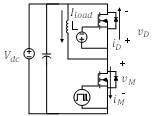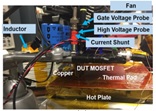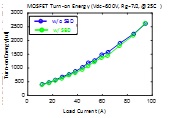LIBRARY
Evaluation of the Reverse Behaviors of the Latest Generations of SiC MOSFET and SiC Schottky Barrier Diode

In this paper, the record high current-rating of CREE's third-generation discrete SiC MOSFET is evaluated. CREE's 1.2kV SiC SBDs are compared according to its current sharing capabilities in parallel with SiC MOSFETs through conducting and switching characteristics, with load currents ranging from 10A to 95A under both room temperature and high temperatures. Fig. 1 shows the double-pulse test setup for the reverse behavior. The diode in Fig. 1 (a) represents a body diode when testing without a SBD in parallel, while that in Fig. 1(b) represents the body diode and the SBD when testing with a SBD in parallel. The hig- temperature setup of the reverse behavior characterization is shown in Fig. 1 (b), where a bent piece of copper is used to transfer heat to the devices being test-ed from the hot plate. Fans are used to cool down the top-side circuits. Fig. 2 shows the comparison between using the freewheeling diode as a body diode and using the freewheeling diode as a body diode in parallel with the SBD under both room temperature and high temperature. As the reverse-recovery behavior of the third-generation SiC MOSFET's body diode is trivial compared to its reverse behavior caused by the output capacitance, the extra reverse energy introduced by the junction capacitance of the SBD actually compensates the elimination of the reverse recovery energy by the SBD. Also, the reverse-recovery behavior of the third-generation SiC MOSFET shows very little increase under high temperatures, and paralleling the SBD does not show much improve-ment under high temperatures, either. In conclusion, for the third-generation SiC MOSFET, the SBD is not necessary to improve reverse-recovery behavior.

























































































